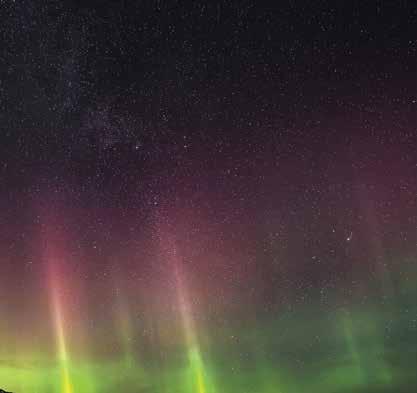
3 minute read
Northern Lights

Names: The Northern Lights are also known as aurora borealis. The term was coined by Galileo Galilei in 1619. “Aurora” is Latin for “dawn” and “Borealis” means “Northern Winds”. They are sometimes referred to as “Polar Lights”, a term that includes the Southern Lights too.
Colour spectrum: Ranging in rarity from white to blue to green to pink and purple, the colour depends on the composition of gases in the Earth’s atmosphere, at what altitude charged solar particles collide with them, and at what speed.
Shapes: The number and the sequence of these collisions creates different shapes and movements. There are four main types: the corona aurora (rays of light), the drapery aurora (ribbons or curtains), the arc aurora (a rainbow) and the diffuse aurora (a hazy glow).



The Original Northern Lights Promise
Sailing on The Hurtigruten Coastal Express has always been the best way to see and enjoy the aurora. We’re so confident of this that we offer you the closest thing you’ll get to a guarantee.
Sail with us on our 12-day Classic Voyage between 1 October and 31 March, and if the Northern Lights don’t appear at least once within sight from the ship, we promise to give you a 6 or 7-day voyage the following Northern Lights season absolutely FREE.
Northern Lights Promise








The Greatest Show on Earth
The Northern Lights are one of the world’s most celebrated natural phenomena for a reason. On our ships, the spectacular sight of the aurora lighting up the night never fails to impress.
Photon-producing particles The aurora occurs when electrically charged particles from the sun, also known as the “solar wind” or “solar storms”, collide with gases in the Earth’s upper atmosphere. The Earth’s magnetic field steers the charged particles towards the North and South poles, forming auroral ovals or zones. The collisions produce photons that appear as jaw-dropping flashes and swirls of light in the sky.
In Pole position In the northern hemisphere, the best chances in Europe of seeing this spectacular light show is in Northern Norway between October and March. Sitting above the Arctic Circle inside the Auroral Zone, it is a region ideally situated for Northern Lights sightings.
Of the 34 ports that The Hurtigruten Coastal Express visits, 22 are above the Arctic Circle. On our 12-day Classic Voyage, you’ll spend six nights in the Auroral Zone, upping your chances of seeing the Northern Lights not just once, but multiple times. A floating observatory There’s nowhere better to see the Northern Lights than sailing along pristine fjords with us, far from the ambient lights on shore. Away from air and light pollution, the visibility and vibrancy of the lights improves, along with your odds of a sighting. And as the ship is on the move, we’ll be passing overcast areas, giving aurora hunters a better likelihood of sailing under clear skies.
Front-row seats You’ll find not knowing exactly when the aurora might appear creates a real sense of suspense and thrill. When you do hear the crew announce a sighting, the frisson of excitement that seems to ripple through the ship is palpable. Everyone hurries up to the observation deck or gazes intently out of the ship’s large windows, eagerly looking skywards.
What patterns, colours, and intensity of light will you be lucky enough to witness on board with us? Each sighting is unique and seeing the aurora parade across the skies, whether for a few minutes or more, is a truly special and magical moment that you’ll cherish forever







